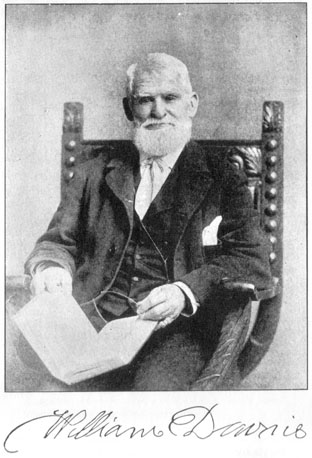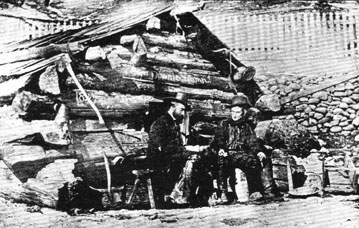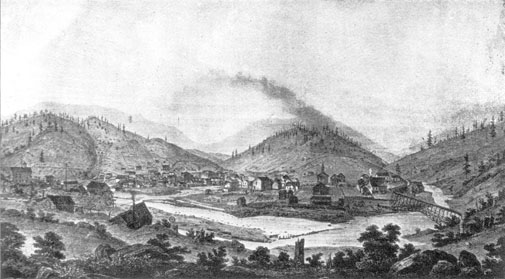"Major" William Downie

William Downie was born in Glasgow on 13 June 1819 (he records in his family bible that he was born in the year in which Hardie and Baird were executed in Glasgow - actually it was in Stirling in 1820 - for their part in the Corn Law uprising). One of eight children of John Downie, a muslin weaver in Glasgow, and his Irish wife Mary Bell, he was brought up in Ayrshire. William "Major" Downie became a gold prospector and explorer who spent most of his life seeking, finding and losing his fortune in gold. He died on December 27, 1893 on board the steamer City of Puebla just before disembarking in San Francisco from Victoria, British Columbia.
His book, Hunting for Gold, was published shortly before his death in 1893, ghost written by a San Francisco journalist, Chris M. Waage. It was published by the California Publishing Company of San Francisco. Few original copies exist but one in the National Library of Congress was reprinted in facsimile in 1971.
[Downie, William (1893, 1971) ed Becker , Robert H. Hunting for Gold. Palo Alto, California: American West Publishing Company]
Copies of this long out of print volume are still available on the second hand market - Amazon.com is a good source and I picked one up for 20 dollars - it took only three days to come . The pictures on this web page are from that book, in which copyright is asserted only on the new material added by the American West Publishing Company. I'd be delighted to be contacted by the heirs of Major William Downie complaining about my breach of copyright!
Hunting for Gold gives scant details of William's origins and life apart from gold prospecting and exploration. What is clear is that he gave his name to the town of Downieville, in Sierra County, California, where he claims to have built the first house, a log cabin, as well as having been one of the first to find gold there in 1849. There is no information at all on how a sailor came to have the title of "Major" - it may have been a term of respect as he appears to have been in British Columbia at the time of the Civil War and is unlikely therefore to have been in the US Army. This theory is supported by this quotation from Hunting for Gold, giving a date of 1851:
".. we were already well settled and kept a sort of open house for all travelers, who were welcome to share anything with us, which we had to eat. Charley Wilkins and Albert Callis, the two colored men, would cook for them and make them feel at home, and as far back as those early days I had become known as Major Downie, and travelers in search of shelter or relief were often told to go to Major Downie's cabin."
A news item in the Oakland News of November 28, 1871 (reprinted in Robert Becker's introduction to the facsimile edition) names William Downie as the founder of Downieville and confirms his claim to have built the first cabin there. It also mentions his marriage to "a Scotch lady" in British Columbia and notes that he "returned with his family to Downieville". In the book, he mentions his brothers in law, Artemis and Douglas Davison, which leads to the conclusion that his wife's maiden surname was Davison.
The book recounts how the young William was attracted to adventure from an early age, when he would watch the waves "rolling in through the North Channel". He first served on board a coastal coal ship, then sailed for Australia out of Glasgow, visiting Sidney and watching the landing of a cargo of convicts "whose greatest offense in many instances consisted in shooting a jack rabbit in the Squire's covers". He mentions sailing to the East Indies and the Isle of France en route to London. The next paragraph is best quoted verbatim as it contains the greatest amount of detail about his personal life:
"My next voyage was to America. I shipped at Donegal for Quebec in the old Spring Hill and arrived there, determined to try my fortune in foreign lands, before returning home. I had a varied experience. I first sailed lakes Ontario and Erie. From there I drifted into the lumber business on Grand River, established a store in Dunville at the mouth of this stream, and ultimately, in partnership with a man named J.C. Hayward, became interested in lumber yards on the Buffalo Shipping Canal.".
It was in Buffalo, while staying at the Love Joy Hotel, where William first heard of the discovery of gold in California. He sailed from Boston to New Orleans on the brig Monterey, then on to San Francisco round Cape Horn on the clipper Architect, under Captain Gray of Baltimore. He arrived in San Francisco on 27 June 1849 and like all on board ship except the officers immediately left the ship. After working for a few days in the city, he sailed from San Francisco on 5 July for Sacramento, arriving there after a voyage of eleven days.
William's first gold prospecting was done at Nye's Ranch, now known as Marysville (across the river from Yuba City), but he injured a finger and took a break from prospecting to go into store-keeping. The urge for gold soon took over and he set off again into the hills in early October 1849, finally coming on a place called the Forks, which appears on the modern map as the junction of the River Downie [the North Fork] with the North Yuba River. His description of the place is quite lyrical:
"The scene that burst upon us was one of marvelous beauty, and after these many years it still lies before me like a lovely panorama, in my recollection of the moment when I first saw it. The silence of the woods was broken only by the rushing of the meeting currents below and the soughing of the breeze through the foliage. The sun was in the western sky, causing a variation of light and shadow to fall upon the landscape, which was exceedingly pleasing. The hillsides were covered with oaks, bending their crooked branches in phantastic forms, while here and there a mighty pine towered above them, and tall willows waved their slender branches, as it were, nodding us a welcome.They grew along the branch of the North Fork, where now stands the Craycroft building, and on the present site of the St. Charles Hotel stood a cluster of pines. Down on the very brink of the river grew a beautiful grove of fire trees, and as we approached, a frightened deer ran from the thicket and made for the woods. Near a little spring, which bubbled up and made the surroundings look fresh and verdant, stood a few pieces of bark on end - the only sign that human foot had ever trod this region, and further indicating that here at some previous time the Indians had camped.
Add to this the waters leaping over rock and bowlders, and the clear azure sky stretching like a canopy over the whole landscape, and you have the picture, as far as I can describe it, that I first beheld, when I approached the Forks."

On 10 December, William Downie and his company moved into the cabin they had built at the Forks.
Other buildings were erected and by 3 March 1850 a meeting at Mr Kelly's cabin set a series of laws governing claims in the upper Yuba district. One of these was "that none but native and naturalized citizens of the United States shall be allowed to hold claims". William was the victim of a lawsuit later in which claim jumpers accused him of not being a US citizen "but I soon vindicated my rights as an American citizen, notwithstanding the fact that I was born in Scotland and 'proud of the land that gave me birth'".
Soon after that meeting, there was a proposal to name the growing township Downieville and the proposer, a Mr Galloway, made the name official on being made a Justice of the Peace, signing his writs as from "Downieville" after his election on 1 June 1850, which may therefore be taken as the date on which the town was officially founded.

Downieville in the 1850s
There is a possible reference to William Downie in Scotland, in the 1841 Census:
Irvine Ayrshire District 595 Enumeration District 3 page 34 Seagate
William Downie 19 male Sailor Y [born in county of Ayrshire] At sea on Census
night
This is reasonably consistent with William's own information in Hunting for Gold - the occupation and age are correct but the birthplace is given as Ayrshire and not Glasgow. As William was not there when the Census was taken, the information may have been provided by a neighbour and so may not be accurate.
William's application for membership of the Society of California Pioneers, in what appears to be his own hand, gives his date and place of birth as 13 June 1820 in Glasgow, but with a correction in a different hand changing the year to 1819 'changed by request of Wm. Downie'. The information in the book conflicts with a date of 1819 as Baird and Hardie were hanged in September 1820. I have so far found no record of the birth of William or any of his siblings in Scottish parish records.
Thanks to a descendant of William's sister Margaret, whom I had not previously known about, I have now (8 June 2009) found out the names of both his parents from Margaret's death certificate (Irvine, 13 November 1890): John Downie, Muslin Weaver and Mary Bell.
There are several possible sources of information in North America and I hope someone with access to records there may be able to help (a number of people have done so since I first put up this page in 2002):
Was the title "Major" an honorary one or did he serve in the US Army?
Where did William Downie take out United States citizenship and do any records still exist?
Does he have descendants who could give more information about his origins?
Michael Carnahan, who ran the Riverside Inn at the Forks in Downieville, is that there was a Downie descendant whom he might be able to contact but when I stayed at the Riverside Inn in 2017, Michael was unable to tell me the identity of the descendant.
However, Jamie Krause, great-great grand daughter of William Downie, contacted me with a good deal of information about his descendants through his daughter, Flora Ellen, and about his wife, Adeline.
The obituary of William's daughter Adeline or Adelina in Prescott, Arizona (1944), states that her brother William John Downie had been employed by the Health Department in Oakland, California for 34 years; Jamie's father thought that he was a milk inspector.
William John's appointment was reported in the San Francisco Call of 15 November 1905, page 6: San Francisco Call 15 November 1905 page 6
APPOINTED MILK INSPECTOR.
Oakland, Nov. 14.—W.J. Downie was to-night appointed to the newly created position of milk inspector by the Board of Health. Downie is a popular young Fifth Warder, with many friends.
[http://chroniclingamerica.loc.gov/lccn/sn85066387/1905-11-15/ed-1/seq-6/ viewed 5 Feb 2014]
William John's death is recorded in the California Death Index 1940-1997: he died on 8 September 1944, only a few months after his sister Adeline, in Napa, California. He married at least twice but I have found no evidence in Census records that he had any children.
John Downie, one of whose descendants still runs the family painting and decorating business in Cleveland, Ohio, was a brother of Major William Downie on the evidence of family letters from John and his son William to the Major; the letters tie the brothers to Irvine in Ayrshire.
John Downie married Janet Parker on 11 July 1841 in Irvine, Ayrshire, which is consistent with William's having been able to see "the waves rolling in through the North Channel" (between Ayrshire and Ireland)
John and Janet were living in Dundonald, Ayrshire, at the time of the 1851 Census (30-31 March 1851) and John's birthplace is given as Irvine, with a note that he was born in Troon village; his age was given as 29 and his occupation Painter, Employing 6 Men and 3 Boys
In the 1841 Census for Irvine (6-7 June 1841), there is a John Downie, Apprentice Painter aged 15-19, born Ayrshire living in the household of Mary Blair or Milne in Irvine, at Eglinton Street West Side; there is also a Jean Downie, Muslin Folder, aged 15-19 in the same household [Mary Blair is mentioned in John's letter to William]
There are no birth or baptism records for either John or Jean (or for any other possible siblings) in either the Irvine parish records or the records of the Associate Congregation.
Is there any information in Downieville or elsewhere which could help trace his past and his descendants?
I stayed for a couple of days in Downieville in June 2017, visited the museum and spoke to a number of local residents, but found no further information.
Information left previously by Downie descendants in Downieville suggests that he was the youngest of four brothers: George (who lived to 95), Robert, James, George and William; the John Downie born in Irvine who moved to Cleveland was younger than William, conflicting with this information
It now seems likely that the information referred to above is at least partly incorrect, based on the death certificate of William's mother Mary Bell, who died in 1855 in Kilmarnock, Ayrshire: an 1855 death certificate in Scotland gives the names of all children of a married woman or widow, and whether they are alive or dead and Mary's lists William, John, James, Mary (dead), Jeanie, Robert, Thomas and Margaret, who was the informant on the certificate (unfortunately, though ages should have been entered, none was given but the usual practice was to list the children in order of age), and all but Mary were listed as living.
The History of Yuba County published in 1879 gives an alternative account of the founding of Downieville, largely consistent with William's except that his forename is given as John.
Is there any evidence about the marriage of William Downie?
Jamie Krause gave the information that William Downie married Adeline Davison on 31 March 1862 at Vancouver Island, British Columbia - I believe that Jamie's evidence comes from the family bible and it is backed up by a marriage notice in The British Columbian in 1862, referenced at http://bc.canadagenweb.org/newspapers/vic_news_bc61_69m.htm [viewed 27 December 2018]
The records available in the British Columbia archives are missing the volume of marriage information for surnames A-J
The marriage was reported in the Sacramento Daily Union Volume 23 no 3460, 1 May 1862: "In Victoria, V. I , March 31st, Major William Downie, formerly of Downieville, to Adeline Davidson."
The 1880 US Census confirms that William's wife's name was Adeline or Adaline and that he had at least three children Flora, William and Adeline, all born in British Columbia between 1865 and 1868
Adeline died on 27 May 1906 and was buried on 29 May 1906 in Bayview Cemetery, Bellingham, Washington - her headstone identifies her as Adeline Downie 1828-1906 and the burial record identifies her only as "Mrs William Downie". Her obituary and death certificate help prove her origins.
Is there a record of his death on board ship to San Francisco on 27 December 1893 and of a subsequent funeral and burial?
Many of the city records for San Francisco were destroyed in the fire following the earthquake in 1906 and it is unlikely that any official record of William's death now exists.
William's death notice appeared in the San Francisco Call of 29 December 1893, page 10:
"Downie—On board steamer City of Puebla, December 27, 1893, William Downie (founder of Downieville, Cal.), a native of Scotland, aged 74 years 6 months and 14 days."
Adeline's obituary states his body was interred in the pioneer burial ground in San Francisco - it is not certain where this burial ground was but most burial grounds in San Francisco have been cleared and used for building. If there was a memorial, it now lies under the foundations of the Golden Gate Bridge.
There are many questions still to be answered. I have made much progress thanks to the world wide web and the people connected to it. If you have any answers to the unanswered questions, or more information on those with answers, please email me